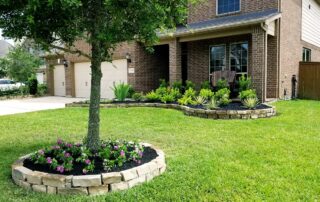How Thick Should Mulch Be in Flower Beds?
Mulch is a fantastic method of protecting your flowers. However, how much mulch is required in flower beds? Mulch ought to be two to four inches thick. Anything less than that will not offer enough protection. It could hinder water from reaching the roots if it's too low.
Clippings of grass clippings
You can enhance the beauty of your flower beds with grass clippings for mulch. They're more sustainable than straw and completely free. They are also able to give moisture and insulation to your plants, which can decrease the rate of evaporation. It is also possible to add nutrients to your soil by using grass clippings that are an excellent source of nitrogen. They can be used as mulch for flowers up to 2 inches thick.
Two to three percent of grass clippings contain nitrogen with 0.3 percent of phosphorous, 1.3% to 2.3 percent potassium, as well as trace elements. The grass clippings can be used to fertilize. The clippings are suitable to create landscaping projects like gardens, lawns, or flower beds.
Composting grass clippings in flower beds is a better choice instead of raking them into the soil. The clippings are more nutritious and will decompose faster if they are composted.
Leaves
Leaf mulch is a great way to enrich soil. It provides soil microbes with an ongoing supply of nutrients and a balanced mix of carbon and nitrogen. Shredded leaves are able to provide nutrients to soils and also act as a natural pest control method by preventing weeds from growing and keeping the soil moist and stopping the growth of weeds.
It's easy and cost-free to make use of leaves as mulch. It is essential to first cut the leaves into pieces. This makes the mulch more effective and also look more attractive. This prevents the soil from getting damp by preventing the growth of mats. Shredded leaves also fall apart faster.
While whole leaves are appealing, problems with infiltration can be a problem. They may also create an encasement that blocks water from getting to the soil, if not cut. They also contribute to acidity and could contain substances that can be harmful to various plants.
Pine needles
The pine needle mulch is an excellent method to mulch flower beds. It will not only reduce weeds, but it will also improve soil porosity and will add nutrients to the soil. It's also easy to remove. It is essential to put down an area of pine needle mulch that is at least two to three inches thick. Mulch that's thick will prevent weeds from growing through it.
The pine needle mulch can be used to cover flower beds to protect your plants from winter. It is recommended to spread the mulch a few inches around the plant's base to shield the roots. The pine needles are placed up to 5 inches over trees or trunks.
Pine needles are an excellent option for flower beds due to the fact that they won't cause soil to shrink. They take a long time to break down and hinder the development of seeds of weeds. The pine needle mulch doesn't need to be replaced each year. They're much lighter than other mulches, making gardening easier for gardeners.
Compost
It's a fantastic soil amendment. It can be added either in the spring or in the fall. It can enrich your soil and will help your plants grow more effectively. It is recommended to apply compost up to 12 inches in depth. Prior to adding compost, the soil should be damp. The soil's moisture can be measured by pressing it. If it's too dry, it won't take in the water.
The most effective compost is completely decomposed. It is dark brown and crumbly, with an earthy scent. It is able to improve soil structure by taking out the soil that is heavy and giving body and texture to soils that are lighter. It also increases the growth rate of all types of plants, including flowers. It can take up to three months for the decomposition process to complete and at a maximum of three years. It is recommended not to make use of compost that hasn't been completely decomposed in flower beds.
It is possible to add compost to your soil at any time of the season. But, it's recommended to do so in the spring and fall following cleaning up the garden. Compost is a great way to improve the appearance of flower beds and other garden areas. Distribute it evenly over the plant's base and in between the rows, at minimum 2 inches distance. It is recommended to add compost to your flower beds at least two times every year. The benefits will become evident in the next few years.

